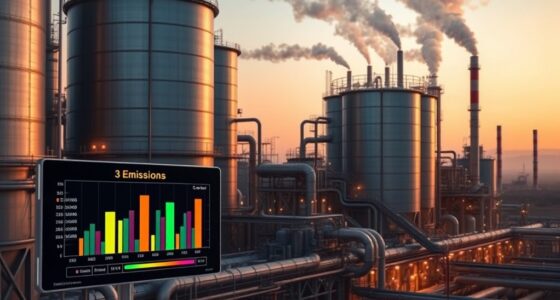In a low-carbon cement future, construction chemicals are key to boosting sustainability. They enhance concrete durability, reduce reliance on traditional cement, and improve resource efficiency. By using eco-friendly admixtures, superplasticizers, and corrosion inhibitors, you can create stronger, longer-lasting structures while lowering environmental impact. These chemicals support recycling efforts and help meet stricter regulations. Discover how these innovative solutions can transform your projects toward greener, more sustainable construction practices as you explore further insights.
Key Takeaways
- Construction chemicals enable the use of low-carbon cements by improving workability and durability without increasing environmental impact.
- They facilitate the incorporation of supplementary cementitious materials, reducing reliance on high-emission Portland cement.
- Advanced admixtures enhance concrete performance, extending lifespan and reducing maintenance, supporting sustainable building practices.
- Chemical solutions promote recycling and reuse of materials, aligning with circular economy principles in low-carbon construction.
- Adoption of eco-friendly chemicals helps meet stricter environmental regulations and accelerates the transition to sustainable, low-carbon cement technologies.

As the construction industry shifts toward a low-carbon future, the role of construction chemicals becomes more critical than ever. These chemicals are key tools in reducing the environmental impact of building materials and processes, particularly when it comes to carbon footprint reduction. You can leverage innovative construction chemicals to improve the sustainability of your projects, making them more eco-friendly from start to finish. By integrating advanced admixtures and coatings, you not only enhance the durability and performance of concrete but also cut down on energy consumption during production and application. This means fewer emissions and a smaller carbon footprint, aligning with global efforts to combat climate change.
Focusing on sustainable material development with construction chemicals allows you to take proactive steps toward greener construction practices. For example, incorporating supplementary cementitious materials like fly ash or slag into your concrete mixes reduces the amount of Portland cement needed. Since cement production is a significant source of carbon dioxide emissions, decreasing its use directly contributes to lowering your project’s overall carbon footprint. Additionally, using chemical admixtures that improve workability and curing efficiency enables you to optimize resource utilization, minimize waste, and accelerate construction timelines—all of which support sustainability goals.
Incorporating supplementary cementitious materials reduces cement use and lowers carbon footprints.
You also have the opportunity to adopt innovative chemical solutions designed specifically for low-carbon cement formulations. These include environmentally friendly superplasticizers and corrosion inhibitors that enhance concrete performance without relying on harmful chemicals. By doing so, you’re not only improving the longevity of your structures but also supporting the development of sustainable materials. These advancements help you meet stricter regulations and client demands for eco-conscious construction without sacrificing strength or safety.
Moreover, the use of construction chemicals tailored for low-carbon cement aligns with the broader movement toward circular economy principles. Many chemical solutions now facilitate the reuse and recycling of construction materials, reducing the need for virgin resources. This approach promotes sustainable material development by closing the loop on material life cycles, conserving resources, and minimizing waste. As you adopt these chemicals, you’re contributing to a construction ecosystem that prioritizes environmental stewardship, resource efficiency, and resilience.
In essence, embracing construction chemicals focused on carbon footprint reduction and sustainable material development empowers you to create environmentally responsible structures. These innovations help you meet the challenges of a low-carbon future, ensuring your projects are not only durable and cost-effective but also aligned with the global push for sustainable development. The strategic application of these chemicals can transform construction practices, making them more environmentally friendly while maintaining the integrity and performance of your builds.
Frequently Asked Questions
How Will Construction Chemicals Adapt to New Low-Carbon Cement Formulations?
You’ll see construction chemicals adapt by developing innovative additive formulations that enhance low-carbon cement’s performance. Eco-friendly curing agents will be prioritized to reduce environmental impact while maintaining durability. These advancements allow you to work with greener materials without sacrificing strength or longevity. As a result, your projects will become more sustainable, aligning with future regulations and eco-conscious building practices, all while ensuring quality and efficiency in construction.
What Environmental Benefits Do Low-Carbon Construction Chemicals Offer?
Low-carbon construction chemicals considerably reduce your project’s carbon footprint and promote resource conservation. By using these innovative chemicals, you help lower greenhouse gas emissions associated with cement production, supporting environmental sustainability. They also enable you to optimize material use, minimizing waste and conserving natural resources. Ultimately, these chemicals contribute to a greener construction process, helping you meet eco-friendly standards and reduce your environmental impact effectively.
Are There Cost Implications for Using Eco-Friendly Construction Chemicals?
You’ll find that eco-friendly construction chemicals often have higher initial costs due to advanced formulations and sustainable sourcing. However, these cost considerations can pay off over time through improved energy efficiency, durability, and reduced environmental impact. Using eco-friendly options can also enhance your market competitiveness by appealing to environmentally conscious clients. While upfront expenses may be higher, the long-term benefits and potential savings make them a smart choice.
How Do Construction Chemicals Impact the Durability of Low-Carbon Cement?
Think of construction chemicals as the guardian angels of low-carbon cement, ensuring your structure’s strength endures. They markedly boost reinforcement durability by enhancing chemical compatibility and protecting against corrosion. Properly selected chemicals create a resilient bond, making your project more durable and sustainable. When you prioritize the right chemical solutions, you’re investing in a future where your construction stands the test of time, resilient against the elements and environmental challenges.
What Regulatory Changes Influence the Development of Sustainable Construction Chemicals?
You’re influenced by policy shifts and evolving compliance standards that drive the development of sustainable construction chemicals. As regulations tighten around environmental impact and safety, you must innovate to meet new requirements. These changes push you to create greener, more efficient chemicals that align with low-carbon goals. Staying ahead means continuously adapting your formulations and practices to guarantee compliance, while contributing positively to sustainable construction practices.
Conclusion
As you embrace low-carbon cement, remember that every small step counts. Construction chemicals can play a crucial role in reducing environmental impact while maintaining strength and durability. Stay innovative and proactive, because, as the saying goes, “A journey of a thousand miles begins with a single step.” By choosing sustainable solutions today, you help build a greener tomorrow—proving that even the smallest changes can lead to significant progress.









